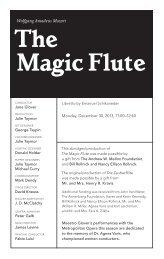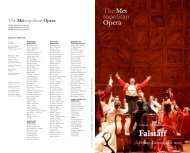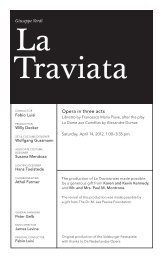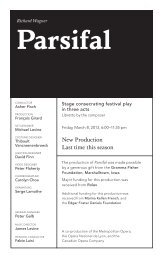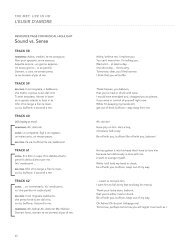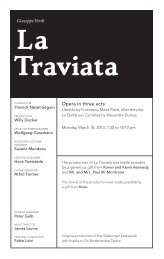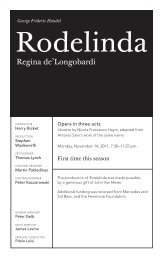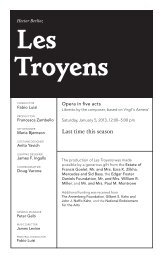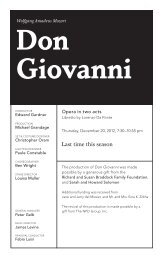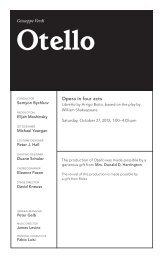Charles Gounod Faust - Metropolitan Opera
Charles Gounod Faust - Metropolitan Opera
Charles Gounod Faust - Metropolitan Opera
Create successful ePaper yourself
Turn your PDF publications into a flip-book with our unique Google optimized e-Paper software.
<strong>Charles</strong> <strong>Gounod</strong><br />
<strong>Faust</strong><br />
CONDUCTOR<br />
Alain Altinoglu<br />
PRODUCTION<br />
Des McAnuff<br />
SET DESIGNER<br />
Robert Brill<br />
COSTUME DESIGNER<br />
Paul Tazewell<br />
<strong>Opera</strong> in five acts<br />
Libretto by Jules Barbier and Michel Carré,<br />
based on Carré’s play <strong>Faust</strong> et Marguerite and<br />
Johann Wolfgang von Goethe’s <strong>Faust</strong>, Part I<br />
Thursday, March 21, 2013, 7:30 to 11:15 pm<br />
First time this season<br />
LIGHTING DESIGNER<br />
Peter Mumford<br />
CHOREOGRAPHER<br />
Kelly Devine<br />
VIDEO DESIGNER<br />
Sean Nieuwenhuis<br />
STAGE DIRECTOR<br />
Jonathon Loy<br />
The production of <strong>Faust</strong> was made possible<br />
by a generous gift from Mercedes T. Bass, and<br />
the Betsy and Edward Cohen/Areté Foundation<br />
Fund for New Productions and Revivals<br />
Additional funding was received from<br />
the Gramma Fisher Foundation, Marshalltown, Iowa;<br />
the Richard J. Massey Foundation for the Arts<br />
and Sciences; and the <strong>Metropolitan</strong> <strong>Opera</strong> Club<br />
GENERAL MANAGER<br />
Peter Gelb<br />
MUSIC DIRECTOR<br />
James Levine<br />
PRINCIPAL CONDUCTOR<br />
Fabio Luisi<br />
<strong>Faust</strong> is a co-production of the <strong>Metropolitan</strong> <strong>Opera</strong> and<br />
English National <strong>Opera</strong>
2012–13 Season<br />
The 748th <strong>Metropolitan</strong> <strong>Opera</strong> performance of<br />
<strong>Charles</strong> <strong>Gounod</strong>’s<br />
<strong>Faust</strong><br />
Conductor<br />
Alain Altinoglu<br />
IN ORDER OF APPEARANCE<br />
<strong>Faust</strong>, a scientist<br />
Piotr Beczala<br />
Méphistophélès<br />
John Relyea<br />
Wagner<br />
Richard Bernstein<br />
Valentin, a soldier,<br />
Marguerite’s brother<br />
Alexey Markov<br />
Siébel, one of<br />
<strong>Faust</strong>’s students<br />
Julie Boulianne<br />
This performance<br />
is being broadcast<br />
live on <strong>Metropolitan</strong><br />
<strong>Opera</strong> Radio on<br />
SiriusXM channel 74<br />
and streamed at<br />
metopera.org.<br />
Marguerite<br />
Marina Poplavskaya<br />
Marthe, Marguerite’s friend<br />
Catherine Cook<br />
Thursday, March 21, 2013, 7:30 to 11:15 pm
KEN HOWARD/METROPOLITAN OPERA<br />
A scene from<br />
<strong>Gounod</strong>’s <strong>Faust</strong><br />
Chorus Master Donald Palumbo<br />
Fight Director Steve Rankin<br />
Assistants to the Set Designer Dustin O’Neill,<br />
Andrew Boyce, Kristin Ellert, Steven Kemp, and<br />
Angrette McCloskey<br />
Assistant to the Costume Designer Michael Zecker<br />
Musical Preparation Jonathan Khuner, Pierre Vallet,<br />
Joshua Greene, and Natalia Katyukova<br />
Assistant Stage Director Yefim Maizel<br />
Prompter Jonathan Khuner<br />
Met Titles Cori Ellison<br />
Scenery, properties, and electrical props contracted<br />
and painted at Cardiff Theatrical Services,<br />
Souvenir, ENO Properties Workshop, and<br />
<strong>Metropolitan</strong> <strong>Opera</strong> Shop<br />
Costumes by ENO Costumes Wardrobe and<br />
<strong>Metropolitan</strong> <strong>Opera</strong> Costume Department<br />
Wigs executed by <strong>Metropolitan</strong> <strong>Opera</strong> Wig<br />
Department<br />
Illusionist Scott Penrose<br />
This performance is made possible in part by public funds<br />
from the New York State Council on the Arts.<br />
This production uses fire and smoke effects.<br />
Before the performance begins, please switch off<br />
cell phones and other electronic devices.<br />
Yamaha is the official piano<br />
of the <strong>Metropolitan</strong> <strong>Opera</strong>.<br />
Latecomers will not be<br />
admitted during the<br />
performance.<br />
Visit metopera.org<br />
Met Titles<br />
To activate, press the red button to the right of the screen in front of<br />
your seat and follow the instructions provided. To turn off the display,<br />
press the red button once again. If you have questions please ask an<br />
usher at intermission.
Synopsis<br />
Act I<br />
<strong>Faust</strong>’s laboratory<br />
Act II<br />
At the inn<br />
Intermission (AT APPROXIMATELY 8:20 PM)<br />
Act III<br />
Outside Marguerite’s house<br />
34<br />
Intermission (AT APPROXIMATELY 9:40 PM)<br />
Act IV<br />
scene 1 Inside Marguerite’s house<br />
scene 2 The inn<br />
scene 3 Outside Marguerite’s house<br />
scene 4 The church<br />
Act V<br />
scene 1 Walpurgis Night<br />
scene 2 The prison<br />
Act I<br />
<strong>Faust</strong> has spent a lifetime in the study of science. Disillusioned, he resolves to<br />
poison himself. He curses God and calls on the Devil. Méphistophélès obligingly<br />
appears and offers <strong>Faust</strong> riches, power, or glory. <strong>Faust</strong>, however, only wants to<br />
recapture the innocence of youth. Méphistophélès agrees to <strong>Faust</strong>’s request, but<br />
there are conditions: on earth <strong>Faust</strong> will be the master, but in the world below<br />
their roles will be reversed. When <strong>Faust</strong> hesitates, Méphistophélès conjures up<br />
a vision of Marguerite. <strong>Faust</strong> signs the contract and returns to his youth.<br />
Act II<br />
Valentin and Wagner are going off to war with the other soldiers, and Valentin is<br />
concerned about leaving his sister Marguerite unprotected. Wagner starts a song<br />
to cheer everyone up, but is interrupted by Méphistophélès. Méphistophélès<br />
tells fortunes: Wagner, it seems, will be killed in his first battle. The flowers that<br />
Siébel picks will wither, and Valentin will meet his death at the hands of someone<br />
close to Méphistophélès. Dissatisfied with the wine on offer, Méphistophélès<br />
conjures up a better vintage to toast Marguerite. This angers Valentin and he<br />
and Méphistophélès draw their swords. Valentin strikes and his blade shatters.<br />
Everyone is convinced they are in the presence of the Devil. Méphistophélès leads
<strong>Faust</strong> to a place where couples are dancing. <strong>Faust</strong> sees Marguerite and offers her<br />
his arm. She refuses, but so charmingly that he is left more entranced than before.<br />
Act III<br />
Siébel gathers flowers for Marguerite outside her house. As Méphistophélès<br />
predicted, they wither, but holy water seems to restore them. Méphistophélès<br />
and <strong>Faust</strong> have been watching, and Méphistophélès leaves a box of jewels for<br />
Marguerite. The atmosphere of innocence surrounding Marguerite’s home moves<br />
<strong>Faust</strong>. Marguerite finds the jewels and puts them on. When she looks in the mirror,<br />
she sees a different woman and is further confused by the encouragement of her<br />
neighbour, Marthe. <strong>Faust</strong> and Méphistophélès return, and Méphistophélès flirts<br />
with Marthe, giving <strong>Faust</strong> the opportunity to seduce Marguerite. She begins to<br />
give in. Méphistophélès conjures up a garden and makes Marthe run off before<br />
disappearing himself. Marguerite realizes she loves <strong>Faust</strong> and they make love.<br />
Act IV<br />
Seduced and abandoned, Marguerite is expecting <strong>Faust</strong>’s child. She is still in<br />
love with him and prays for him and their unborn child.<br />
The soldiers, including Valentin, return. Siébel tries to stop him from seeing<br />
Marguerite but Valentin, suspecting the worst, pushes him aside.<br />
Outside her house, Méphistophélès serenades Marguerite on <strong>Faust</strong>’s behalf.<br />
Valentin and <strong>Faust</strong> fight and, with the intervention of Méphistophélès, Valentin<br />
is fatally wounded. Marguerite watches her brother die and hears him curse her<br />
with his last breath.<br />
Distraught, Marguerite goes to church to pray for forgiveness. Hearing the voice<br />
of Méphistophélès telling her that she is damned, she collapses in terror.<br />
Act V<br />
Walpurgis Night. <strong>Faust</strong> and Méphistophélès are surrounded by a group of<br />
demons. <strong>Faust</strong> is shown a vision of Marguerite: she has been imprisoned for<br />
infanticide and gone insane.<br />
With Méphistophélès’s help, <strong>Faust</strong> goes to the prison in an attempt to save<br />
Marguerite. She seems to recognize her lover and recalls the night when he first<br />
seduced her. <strong>Faust</strong> is overwhelmed with pity. Marguerite panics at the sight of<br />
the Devil and, with a frantic appeal to heaven, she dies. Méphistophélès damns<br />
her but angelic voices proclaim she is saved.<br />
—Courtesy of English National <strong>Opera</strong><br />
Visit metopera.org<br />
35
In Focus<br />
<strong>Charles</strong> <strong>Gounod</strong><br />
<strong>Faust</strong><br />
36<br />
Premiere: Théâtre Lyrique, Paris, 1859<br />
One of many adaptations of the old story of an aged philosopher’s pact with<br />
the devil, <strong>Faust</strong> is loosely based on Goethe’s epic drama of the same name. The<br />
philosophical issues of the play are largely jettisoned in favor of a story whose<br />
most immediate concern is the tension between the longing for youth and love<br />
and the desire for salvation. <strong>Faust</strong> was a moderate success at its premiere, but<br />
was subsequently reworked and enlarged, and its wealth of melody made it<br />
extraordinarily popular throughout the opera world—too popular, perhaps, for<br />
its own standing in critical and intellectual circles, where it came to be seen<br />
as a crowd-pleasing, oversimplified adaptation of a towering work of literature.<br />
Today that view has largely abated, and the opera can be appreciated for its<br />
sheer beauty, its straightforward presentation of timeless human themes, and<br />
its opportunities for superb and exciting singing.<br />
The Creators<br />
<strong>Charles</strong> <strong>Gounod</strong> (1818–1893) showed early promise as a musician and achieved<br />
commercial success with <strong>Faust</strong>. His opera Roméo et Juliette (1867) was equally<br />
well received in its day and remains in the repertory. Among his most famous<br />
works is a setting of the Ave Maria based on a piece by J. S. Bach. Later in<br />
life he composed several oratorios. Jules Barbier (1825–1901) and Michel Carré<br />
(1821–1872) were the leading librettists of their time in France, providing the text<br />
for many other successful operas, including Roméo for <strong>Gounod</strong>, Mignon (also<br />
from Goethe) and Hamlet for Ambroise Thomas, and Les Contes d’Hoffmann<br />
for Jacques Offenbach. Johann Wolfgang von Goethe (1749–1832) is the<br />
preeminent figure of German literature. The author of <strong>Faust</strong> and The Sorrows<br />
of Young Werther (the source for an opera by Massenet), he was also a wellregarded<br />
authority on philosophy, art, and especially music.<br />
The Setting<br />
The traditional setting for <strong>Faust</strong> is 16th-century Germany, a time when alchemists<br />
and philosophers were familiar characters in real life. Des McAnuff’s production<br />
places the action in the first half of the 20th century.<br />
The Music<br />
The score is replete with the elegance and romanticism of mid-19th century<br />
French opera—notably in the beautiful prelude and in the ballet music in Act V<br />
(which is often omitted but largely restored in this production). <strong>Gounod</strong>’s talent
for religious music is apparent in the magnificent chorale invoked against<br />
the devil’s power in Act II and, by way of parody, in the devil’s own music that<br />
oppresses Marguerite in the church scene in Act IV. The chorus is featured<br />
prominently and in very different ways throughout the opera, from the rousing<br />
and unforgettable Soldiers’ Chorus in Act IV to the ethereal singing of the<br />
angels in the finale. But it is the diverse music for the lead roles that has assured<br />
this opera’s place in the repertory. Their solos are among the most cherished in<br />
opera: the tenor’s lyrical greeting of his beloved’s humble home in Act III (“Salut!<br />
demeure chaste et pure”); the bass-baritone’s infernal drinking song in Act II<br />
(“Le veau d’or”) and his ribald, mocking laughing song in Act IV (“Vous qui faites<br />
l’endormie”); the baritone’s ravishing farewell aria in Act II (“Avant de quitter ses<br />
lieux”); and above all the soprano’s coloratura extravaganza, the famous Jewel<br />
Song in Act III (“Ah! Je ris de me voir si belle”). The inherent beauty and charm<br />
of these solos often disguise their technical difficulty—each of them requires<br />
an extraordinary level of breath control and musical taste to be brought to life.<br />
This becomes even more pronounced in the memorable passages for multiple<br />
voices, such as the Act III quartet, which deftly combines romantic and comic<br />
elements, and most notably in the soaring trio for soprano, tenor, and bass that<br />
forms the opera’s musical and dramatic climax.<br />
<strong>Faust</strong> at the Met<br />
The first <strong>Metropolitan</strong> <strong>Opera</strong> House, on Broadway and 39th Street, opened with<br />
a performance of <strong>Faust</strong>, sung in Italian, on October 22, 1883. The work remained<br />
the most frequently heard opera at the Met well into the 20th century. Between<br />
1886 and 1889 it was performed in German, then reverted to Italian and finally<br />
to the original French. An 1891 tour performance in Chicago for the first time<br />
brought together the impressive lineup of Emma Eames (Marguerite) and<br />
brothers Jean (<strong>Faust</strong>) and Edouard de Reszke (Méphistophélès). Jean de Reszke<br />
went on to sing the title role 71 times at the Met, while Edouard performed<br />
the part of the devil an astounding 112 times through 1903. The other great<br />
Méphistophélès of this era was Pol Plançon, who appeared 85 times between<br />
1893 and 1908. Designer Joseph Urban and conductor Pierre Monteux made<br />
their joint Met debuts with a new production in 1917 that starred Geraldine Farrar<br />
and Giovanni Martinelli. Among the artists who appeared in this version over<br />
the following decades were Licia Albanese, Dorothy Kirsten, Frank Guarrera,<br />
and Ezio Pinza. It was replaced in 1953 by the debut production of Peter Brook,<br />
designed by Rolf Gérard and again conducted by Monteux, with Jussi Björling,<br />
Victoria de los Angeles, and Robert Merrill as Valentin. Opening night of 1965<br />
witnessed the debut Met production of Jean-Louis Barrault, who directed<br />
Nicolai Gedda, Gabriella Tucci, and Cesare Siepi, with Georges Prêtre on the<br />
podium. Harold Prince made his Met debut with a 1990 production that featured<br />
Neil Shicoff, Carol Vaness, and James Morris. In 2005 director Andrei Serban<br />
and Met Music Director James Levine helmed another new staging that starred<br />
Roberto Alagna, Soile Isokoski, René Pape, and Dmitri Hvorostovsky. The current<br />
production opened November 29, 2011, with Yannick Nézet-Séguin conducting<br />
Jonas Kaufmann, Marina Poplavskaya, and Pape in the leading roles.<br />
Visit metopera.org<br />
37
Program Note<br />
The legendary German poet, playwright, novelist, and scientist Johann<br />
Wolfgang von Goethe first began working on his epic drama <strong>Faust</strong> as<br />
early as 1772, when he was just 23 years old and a recent graduate of law<br />
school. He could not have known then that his toil on the project would occupy<br />
him for the rest of his life, stretching to enormous proportions and not reaching<br />
its completion until the year of his death six decades later. What he did know,<br />
however, was that he wanted to eventually see <strong>Faust</strong> set to music. Goethe was<br />
clearly a man of good taste in this regard, as he approached Mozart to suggest<br />
a collaboration in the early stages of his writing. Sadly, by the time Goethe finally<br />
managed to complete Part I around 1806, Mozart—despite being seven years<br />
Goethe’s junior—was 15 years in the grave. And when the finishing touches were<br />
put to Part II in 1832, music itself had changed tremendously. Beethoven had<br />
come and gone, turning the world on its ear and ushering in Romanticism in the<br />
20 short, stormy years between the “Eroica” (1804) and the Ninth Symphony<br />
(1824). Despite his dream of having his work turned into an opera, Goethe<br />
had no faith in the young Romantics, declaring that—regardless of his death—<br />
Mozart was still the only composer worthy of setting <strong>Faust</strong> to music.<br />
Ironically, the Romantics felt entirely the opposite about Goethe. He became<br />
the most important poetic touchstone for 19th-century German composers,<br />
inspiring countless works by Beethoven, Schubert, Brahms, Liszt, Schumann,<br />
Wolf, and many others. <strong>Faust</strong>, though, remained intimidating. Goethe’s<br />
ultimate masterpiece stretches to several hundred pages of text, depending<br />
on the edition, and concerns itself with a dizzying array of profound topics:<br />
philosophy, mythology, theology, temptation, desire, love, human nature, the<br />
quest for knowledge, the meaning of life, and the mystery of the afterlife. To<br />
make matters worse, there was also the issue of Mozart’s shadow. As Schumann<br />
wrote to Mendelssohn while planning his oratorio Szenen aus Goethes <strong>Faust</strong>,<br />
any composer hoping to set <strong>Faust</strong> “would not only be judged by his treatment<br />
of one of the seminal and most widely acclaimed works in German literature,<br />
but would also be setting himself up to be compared to Mozart.” Perhaps it is<br />
not surprising, then, that the most enduringly popular musical work based on<br />
<strong>Faust</strong> was written by a Frenchman, takes as its starting point a loose Frenchlanguage<br />
adaptation of the text, and makes no attempt to match the scope and<br />
profundity of the original drama.<br />
<strong>Charles</strong> <strong>Gounod</strong> began work on his <strong>Faust</strong> in 1856. At the time, he was not a<br />
prominent opera composer; his modest reputation rested mainly on his body of<br />
religious music and his having won the Prix de Rome in 1839. He had completed<br />
two previous operas, Sapho and La Nonne Sanglante—both of which were<br />
produced at the Académie Impériale de Musique (more commonly known as<br />
the Paris <strong>Opera</strong>)—but both were failures. Determined to have a hit, he came<br />
up with a new idea: an opera on Goethe’s <strong>Faust</strong>. It was rejected. The <strong>Opera</strong>’s<br />
Visit metopera.org<br />
39
Program Note CONTINUED<br />
impresario cited concerns that the work would not be spectacular enough, but<br />
one has to wonder whether it had more to do with the composer’s two earlier<br />
flops. In any case, the emerging Théâtre Lyrique swooped in to ask that <strong>Gounod</strong><br />
write <strong>Faust</strong> for its stage instead, and he jumped at the opportunity.<br />
<strong>Gounod</strong>’s librettists were nominally Jules Barbier and Michel Carré, but<br />
Carré’s main contribution was to allow Barbier a free hand in drawing much of the<br />
libretto’s text from Carré’s <strong>Faust</strong> et Marguerite, a three-act “drame fantastique”<br />
based loosely on Part I of Goethe’s play. In Carré’s drama and <strong>Gounod</strong>’s<br />
opera, the tale is thinned down to its basics. Rather than an all-encompassing<br />
rumination on the human condition, we have a simple, affecting love story: man<br />
seduces woman, abandons her, realizes too late that he is truly in love, and<br />
attempts to rescue her from tragic circumstances of his own making. That there<br />
is a demonic bargain thrown into the mix seems almost an afterthought. But the<br />
drastic shift in tone and reduction of ambition compared to Goethe’s original<br />
are also the reasons for the opera’s success. Schumann, et al. were right—<br />
attempting to create an operatic equivalent of Goethe’s star-gazing drama is<br />
a fool’s errand. But at the heart of it is a down-to-earth, grippingly human story<br />
fairly begging for music. (To distance <strong>Faust</strong> the opera from the play, it is to this<br />
day often performed under the title Margarethe in German-speaking countries,<br />
a practice introduced in 1861 in Dresden.)<br />
<strong>Faust</strong> premiered at the Théâtre Lyrique in 1859, but it took a decade and<br />
multiple revisions before it settled into “completed” form. <strong>Gounod</strong> made<br />
various cuts during rehearsals for the premiere and continued to experiment<br />
with including and omitting a variety of scenes in subsequent performances. The<br />
original version also contained spoken dialogue rather than recitative; <strong>Gounod</strong><br />
had to go back the following year and write music for those sections so the<br />
work could be performed outside France. For an 1864 London production, he<br />
added Valentin’s famous Act II aria, “Avant de quitter ces lieux,” for the popular<br />
baritone <strong>Charles</strong> Santley, who was annoyed at his character’s lack of opportunity<br />
for vocal display. The most important addition, though, came in 1869, when the<br />
work finally made it onto the stage of the Paris <strong>Opera</strong>, for which <strong>Gounod</strong> had<br />
intended it in the first place. Here, a show was not complete without a ballet, so<br />
<strong>Faust</strong>’s fifth act gained a 20-minute dance section in the Walpurgis Night scene.<br />
Though this is one of many operas that have been subjected to vicious cuts<br />
over the years, audiences today generally hear the full—or almost full—score.<br />
For this Met production, most of the ballet (the only section of the opera still<br />
frequently omitted in performance) has been restored.<br />
The first production at the Théâtre Lyrique was only modestly successful, but<br />
<strong>Faust</strong> did eventually become <strong>Gounod</strong>’s hit. Following the Paris premiere, the<br />
publisher Antoine de Choudens bought the rights for a bargain 10,000 francs<br />
and took the opera on tour through Germany, Belgium, Italy, and England,<br />
40 Visit metopera.org
Program Note CONTINUED<br />
accumulating increasing popular acclaim along the way. <strong>Faust</strong> was revived in<br />
Paris in 1862 for the inauguration of the Théâtre Lyrique’s new hall and proved a<br />
massive success. After the 1869 production at the <strong>Opera</strong>, it went from success to<br />
sensation, becoming the most frequently performed opera in Paris and holding<br />
that position for a long time. By 1975 it had been given more than 2,000 times<br />
at the <strong>Opera</strong> alone. <strong>Faust</strong> also took the rest of the world by storm, eventually<br />
being translated into at least 25 languages, and was likely the most frequently<br />
performed opera worldwide in the late 19th century.<br />
It was no different in New York. On October 22, 1883, the <strong>Metropolitan</strong> <strong>Opera</strong><br />
opened its inaugural season with <strong>Faust</strong>. A decade later, when the house reopened<br />
after a devastating fire had caused a dark season, <strong>Faust</strong> was again chosen as the<br />
celebratory centerpiece. Since then, the company has presented more than 700<br />
performances. And though the popularity of <strong>Gounod</strong>’s masterpiece has waned<br />
somewhat in the last 50 years or so, it still claims a comfortable place in the heart<br />
of the repertoire, seeing the stage more than any other French-language opera<br />
save Bizet’s Carmen and Offenbach’s Les Contes d’Hoffmann.<br />
—Jay Goodwin<br />
Visit metopera.org<br />
43
The Cast<br />
Alain Altinoglu<br />
conductor (paris, france)<br />
this season Otello and <strong>Faust</strong> at the Met, Der Fliegende Holländer at the Zurich <strong>Opera</strong><br />
and London’s Royal Albert Hall, Henri Rabaud’s Mârouf, Savetier du Caire at Paris’s Opéra<br />
Comique, and orchestral engagements in Paris, Dresden, Mannheim, Zurich, Lyon, and<br />
Vienna, among others.<br />
met appearances Carmen (debut, 2010).<br />
career highlights His recent opera projects include <strong>Faust</strong> at the Paris <strong>Opera</strong> and Vienna<br />
State <strong>Opera</strong>, Falstaff at the Vienna State <strong>Opera</strong>, Massenet’s Cendrillon at Brussels’s La<br />
Monnaie, Rigoletto in Cologne, and Prokofiev’s The Love for Three Oranges at the Paris<br />
<strong>Opera</strong>. He has also led Don Giovanni at Covent Garden and the Paris <strong>Opera</strong>, <strong>Faust</strong> at the<br />
Berlin State <strong>Opera</strong>, and Falstaff at Paris’s Théâtre des Champs-Élysées. He has conducted<br />
the Berlin Staatskapelle, Orchestre National d’Île-France, and Lyon Orchestra, and at the<br />
San Francisco <strong>Opera</strong>, Salzburg Festival, and at Buenos Aires’s Teatro Colón.<br />
Julie Boulianne<br />
mezzo-soprano (dolbeau-mistassini, canada)<br />
this season Siébel in <strong>Faust</strong> and Ascanio in Les Troyens at the Met, Romeo in I Capuleti e<br />
i Montecchi with L’Opéra de Reims, and her debut with the Boston Symphony Orchestra.<br />
met appearances Diane in Iphigénie en Tauride (debut, 2011) and Stéphano in Roméo et<br />
Juliette.<br />
career highlights Recent performances include Miranda in Thomas Adès’s The Tempest<br />
for her debut with the Quebec <strong>Opera</strong>, her Japanese debut at the Saito Kinen Festival<br />
in Honegger’s Jeanne d’Arc au Bûcher, and her Mostly Mozart debut in Haydn’s Nelson<br />
Mass. She has also sung the title role of Handel’s Tolomeo with the Glimmerglass <strong>Opera</strong>,<br />
Lazuli in Chabrier’s L’Étoile with New York City <strong>Opera</strong>, Cherubino in Le Nozze di Figaro<br />
with Vancouver <strong>Opera</strong>, the title role of Massenet’s Cendrillon in Montreal and Marseille,<br />
and Angelina in La Cenerentola at Aspen <strong>Opera</strong> Theater, Florida Grand <strong>Opera</strong>, and<br />
Glimmerglass <strong>Opera</strong>. Additional performances include Rosina in Il Barbiere di Siviglia<br />
with the Minnesota <strong>Opera</strong> and Zerlina in Don Giovanni in Avignon.<br />
44
Marina Poplavskaya<br />
soprano (moscow, russia)<br />
this season Marguerite in <strong>Faust</strong> at the Met, Alice in Meyerbeer’s Robert le Diable at Covent<br />
Garden, Lucrezia in I Due Foscari at the Los Angeles <strong>Opera</strong>, Gutrune in Götterdämmerung<br />
at the Deutsche Staatsoper Berlin and La Scala, and Violetta in La Traviata for the<br />
Netherlands <strong>Opera</strong>.<br />
met appearances Elisabeth in Don Carlo, Violetta, Liù in Turandot, and Natasha in War and<br />
Peace (debut, 2007).<br />
career highlights Recent performances include Violetta at Covent Garden, the Deutsche<br />
Staatsoper Berlin, and Munich’s Bavarian State <strong>Opera</strong>, Marfa in The Tsar’s Bride at Covent<br />
Garden, Amelia in Simon Boccanegra at the Vienna State <strong>Opera</strong>, Leonora in Il Trovatore<br />
in Brussels, and Micaëla in Carmen in Barcelona. She has also sung Rachel in La Juive,<br />
Amelia, Tatiana in Eugene Onegin, Donna Anna in Don Giovanni, and Elisabeth at Covent<br />
Garden, Desdemona in Otello at the Salzburg Festival and Rome <strong>Opera</strong>, Marguerite at<br />
the Berlin State <strong>Opera</strong>, Mathilde in Guillaume Tell in Amsterdam, and Maria in Mazeppa<br />
and Anne Trulove in The Rake’s Progress at the Bolshoi <strong>Opera</strong>.<br />
Piotr Beczala<br />
tenor (czechowice-dziedzice, poland)<br />
this season The Duke in Rigoletto and the title role of <strong>Faust</strong> at the Met, Rodolfo in La<br />
Bohème at La Scala and the Vienna State <strong>Opera</strong>, the Prince in Rusalka in Warsaw, Alfredo<br />
in La Traviata with Munich’s Bavarian State <strong>Opera</strong>, and Roméo in Roméo et Juliette with<br />
the Vienna State <strong>Opera</strong>.<br />
met appearances Des Grieux in Manon, Rodolfo, Roméo, Lenski in Eugene Onegin, and<br />
the Duke (debut, 2006).<br />
career highlights Don Ottavio in Don Giovanni, the Italian Tenor in Der Rosenkavalier,<br />
Vaudémont in Iolanta, and the Prince at the Salzburg Festival, the Duke at Covent Garden<br />
and La Scala, Alfredo in Munich and Berlin, and Werther in Frankfurt and Munich. He has<br />
also sung Tamino in Die Zauberflöte in Vienna, Berlin, and Paris, Jeník in The Bartered<br />
Bride with the Paris <strong>Opera</strong> and in Zurich, Rodolfo in Amsterdam, Vaudémont in Vienna<br />
and Moscow, and Lenski at Paris’s Bastille <strong>Opera</strong> and for his 2004 United States debut<br />
with the San Francisco <strong>Opera</strong>.<br />
45
The Cast CONTINUED<br />
Alexey Markov<br />
baritone (viborg, russia)<br />
this season Valentin in <strong>Faust</strong> and di Luna in Il Trovatore at the Met, di Luna at Munich’s<br />
Bavarian State <strong>Opera</strong>, and Nottingham in Roberto Devereux, Enrico in Lucia di Lammermoor,<br />
and Count Anckarström in Un Ballo in Maschera in Zurich.<br />
met appearances Marcello in La Bohème, Shchelkalov in Boris Godunov, Tomsky in The<br />
Queen of Spades, and Prince Andrei in War and Peace (debut, 2007).<br />
career highlights He has sung Robert in Tchaikovsky’s Iolanta at Madrid’s Teatro Real, Fyodor<br />
Poyarok in Rimsky-Korsakov’s The Legend of the Invisible City of Kitezh with the Netherlands<br />
<strong>Opera</strong>, Yeletsky in The Queen of Spades and the title role of Eugene Onegin in Lyon, di<br />
Luna in Bordeaux, Eugene Onegin in Monte Carlo, Iago in Otello in Dresden, and Scarpia<br />
in Tosca in Frankfurt. He was a first-prize winner of St. Petersburg’s Rimsky-Korsakov Vocal<br />
Competition and the Obraztsova Competition.<br />
John Relyea<br />
bass-baritone (toronto, canada)<br />
this season Méphistophélès in <strong>Faust</strong> at the Met, Bertram in Meyerbeer’s Robert le Diable<br />
at Covent Garden, the Four Villains in Les Contes d’Hoffmann at Munich’s Bavarian State<br />
<strong>Opera</strong>, his first Zaccaria in Nabucco with the Minnesota <strong>Opera</strong>, and King Marke in concert<br />
performances of Tristan und Isolde with the Chicago Symphony Orchestra.<br />
met appearances Colline in La Bohème, Escamillo in Carmen, Figaro in Le Nozze di Figaro,<br />
Alidoro in La Cenerentola (debut, 2000), Raimondo in Lucia di Lammermoor, Banquo in<br />
Macbeth, Garibaldo in Rodelinda, Giorgio Walton in I Puritani, the Night Watchman in<br />
Die Meistersinger von Nürnberg, Don Basilio in Il Barbiere di Siviglia, Masetto in Don<br />
Giovanni, and Méphistophélès in La Damnation de <strong>Faust</strong>.<br />
career highlights Méphistophélès in La Damnation de <strong>Faust</strong> for his debut with the Lyric<br />
<strong>Opera</strong> of Chicago, the title role in Bluebeard’s Castle with the Seattle <strong>Opera</strong>, the Four<br />
Villains and Escamillo at the Vienna State <strong>Opera</strong>, Figaro in Munich, Nick Shadow in The<br />
Rake’s Progress and Banquo at Covent Garden, Escamillo at Paris’s Bastille <strong>Opera</strong>, and<br />
Cadmus/Somnus in Semele, Colline, and Raimondo at Covent Garden and the San<br />
Francisco <strong>Opera</strong>. Recipient of the Met’s 2008 Beverly Sills Artist Award, established<br />
by Agnes Varis and Karl Leichtman.<br />
46



